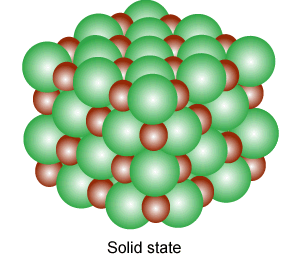A cubic solid is made up of two elements $X$ and $Y$ Atoms of $X$ are present on every alternate corner and one at the enter of cube $Y$ is at $\frac{1}{3} td$ of the total faces The empirical formula of the compound is
A cubic solid is made up of two elements $X$ and $Y$ Atoms of $X$ are present on every alternate corner and one at the enter of cube $Y$ is at $\frac{1}{3} td$ of the total faces The empirical formula of the compound is
- $X _2 Y _{1.5}$
- $X _{2.5} Y$
- $XY _2, 5$
- $X _{1.5} Y _2$
The Correct Option is B
Solution and Explanation
2. Atoms at faces contribute $\frac{1}{2}$ of their count to the unit cell.
3. By calculating individual contributions of X and Y, the correct empirical formula is derived as X$_{2.5}$Y.
Top Questions on The solid state
- A metal crystallizes in simple cubic lattice. The volume of one unit cell is \( 6.4 \times 10^{-7} \, \text{pm}^3 \). What is the radius of the metal atom in pm?
- AP EAPCET - 2025
- Chemistry
- The solid state
- A metal crystallises in two cubic phases, fcc and bcc with edge lengths 3.5 Å and 3 Å respectively. The ratio of densities of fcc and bcc is approximately
- TS EAMCET - 2025
- Chemistry
- The solid state
- The percentage of free space in a body-centred cubic unit cell is
- Bihar Board XII - 2025
- Chemistry
- The solid state
- How many kinds of Bravais lattice are possible in a crystal?
- Bihar Board XII - 2025
- Chemistry
- The solid state
- The number of atoms present in body-centred cubic unit cell is
- Bihar Board XII - 2025
- Chemistry
- The solid state
Questions Asked in JEE Main exam
A square loop of sides \( a = 1 \, {m} \) is held normally in front of a point charge \( q = 1 \, {C} \). The flux of the electric field through the shaded region is \( \frac{5}{p} \times \frac{1}{\varepsilon_0} \, {Nm}^2/{C} \), where the value of \( p \) is:

- JEE Main - 2025
- Gauss's Law
- Let \( \alpha_1 \) and \( \beta_1 \) be the distinct roots of \( 2x^2 + (\cos\theta)x - 1 = 0, \ \theta \in (0, 2\pi) \). If \( m \) and \( M \) are the minimum and the maximum values of \( \alpha_1 + \beta_1 \), then \( 16(M + m) \) equals:
- JEE Main - 2025
- Binomial Expansion
- Let the foci of a hyperbola be \( (1, 14) \) and \( (1, -12) \). If it passes through the point \( (1, 6) \), then the length of its latus-rectum is:
- JEE Main - 2025
- Hyperbola
- Which of the following is the correct IUPAC name of the given organic compound (X)? The structure of compound $ X $ is as follows: $ \text{H}_3\text{C} - \text{CH}_3 - \text{CH} = \text{CH} - \text{H} - \text{Br} $
- JEE Main - 2025
- Nomenclature Of Organic Compounds
- Suppose A and B are the coefficients of the 30th and 12th terms respectively in the binomial expansion of \( (1 + x)^{2n - 1} \). If \( 2A = 5B \), then \( n \) is equal to:
- JEE Main - 2025
- Coordinate Geometry
Concepts Used:
Solid State
Solids are substances that are featured by a definite shape, volume, and high density. In the solid-state, the composed particles are arranged in several manners. Solid-state, in simple terms, means "no moving parts." Thus solid-state electronic devices are the ones inclusive of solid components that don’t change their position. Solid is a state of matter where the composed particles are arranged close to each other. The composed particles can be either atoms, molecules, or ions.

Types of Solids:
Based on the nature of the order that is present in the arrangement of their constituent particles solids can be divided into two types;
- Amorphous solids behave the same as super cool liquids due to the arrangement of constituent particles in short-range order. They are isotropic and have a broad melting point (range is about greater than 5°C).
- Crystalline solids have a fixed shape and the constituent particles are arranged in a long-range order.